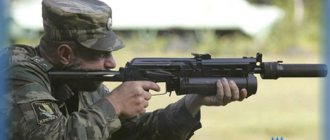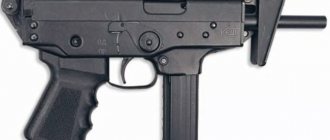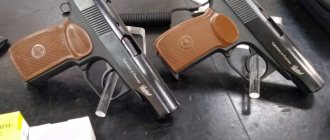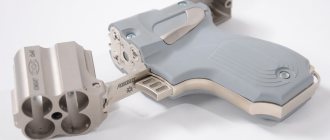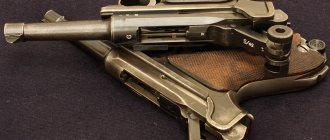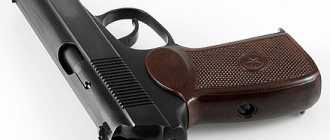Automatic pistols OTs-23 “Dart” and OTs-33 “Pernach” (Russia)
After the Stechkin automatic pistol (APS) was discontinued from production and then out of service, a niche appeared in the ranks of Soviet service weapons that required prompt filling. An attempt to replace automatic pistols with 5.45 mm and 7.62 mm Kalashnikov assault rifles only partially solved the problem. If during combat operations in the field the riflemen only benefited from this replacement, then during operations in populated areas and on city streets, the specifics of firing from a machine gun created an additional danger for others. Despite this, they began to come to grips with solving the problem only in the early 1990s.
The first attempt to equip employees of the Russian Ministry of Internal Affairs with an automatic pistol was made in 1993. However, for a number of reasons, work on creating a new automatic pistol (based on the modernization of the APS) was stopped almost at the very beginning. Another attempt was made the following year. The management of the Tula TsKIB for sporting and hunting weapons received the task of developing an automatic pistol chambered for the 5.45×18 MPTs cartridge (created in 1969 at TsNIITochMash by designer A.D. Denisova, used in the PSM pistol). This theme was codenamed “Dart”, which later became the semi-official name of the pistol developed within its framework.
OTs-23 "Dart"
The team of Tula designers involved in the development of a new pistol was headed by the famous Russian designer, who has extensive experience in creating such systems, I.Ya. Stechkin. Already at the end of 1994, customers were presented with a model of an automatic pistol, which received the code OTs-23 (“TsKIB SOO Sample” No. 23) adopted by TsKIB SOO and the name in honor of its creators AP SBZ (Stechkin, Baltzer, Zinchenko automatic pistol). The OTs-23 had, perhaps, a record magazine for a pistol with a capacity of 24 rounds. However, the main distinguishing feature of the new pistol was its ability to fire both single shots and short bursts.
Read: Design of the SME pistol "Groza"
For this purpose, its design included a special mechanism for cutting off bursts of 3 shots. The rest of the automatics (as well as the design) of the pistol are built according to the classical scheme, to which some original solutions were introduced.
During testing, the OTs-23 showed fairly good results when firing single shots. When firing in bursts, high accuracy of fire was noted. This was achieved through the use of another successful solution in its design - a muzzle brake-compensator in the form of a hole in the barrel and the bolt casing. Part of the powder gases emitted through it reduced the jump of the weapon. In addition, the pistol demonstrated the high penetration ability characteristic of a small caliber (according to some sources, a bullet fired from the OTs-23 penetrates up to 45 layers of Kevlar), and compensated for the disadvantage inherent in “small caliber” guns - low stopping power - by hitting the target with several bullets when firing in bursts.
In 1995, the OTs-23 pistol successfully passed tests and was recommended for use as an automatic service weapon. Experts believe that it may well replace the PSM pistol, which has a similar caliber, since it is significantly superior to it in efficiency, and the ability to fire in bursts puts the OTs-23 on a par with large-caliber pistols in terms of lethality. However, the author was unable to find documentary evidence of the adoption and use of this pistol model.
According to some reports, the pistol is entering service with operatives of the Ministry of Internal Affairs of the Russian Federation.
Even during testing of the OTs-23 “Dart” automatic pistol, experts came to the conclusion that the excellent technical ideas embedded in its design and good characteristics were negated by the shortcomings of the cartridge used in it. The low power and weak stopping effect of the 5.45 mm cartridge significantly limited the scope of use of the new weapon.
Read: Soviet high-altitude fighter MIG-3
In mid-1995, a group of designers, under the leadership of I.Ya. Stechkina, who created the OTs-23, spoke about the possibility of creating a new automatic pistol (based on the OTs-23), chambered for the 9x19 “Parabellum” cartridge. This idea aroused interest among the leadership of the Russian Ministry of Internal Affairs, and funds were allocated for its implementation. The only requirement of representatives of law enforcement agencies is the use of the Soviet 9x18 PM cartridge and its reinforced analogue 9x18 PMM in the new automatic pistol.
OTs-33 "Pernach"
Work on the new pistol proceeded at a record pace for gunsmiths. The TsKIB SOO design team received an order to create a 9 mm automatic pistol at the end of 1995, and after 4 months the prototype model was ready for testing. By tradition, the new pistol received several official and unofficial names. It was presented to customers under the standard name for TsKIB SOO OTs-33 (“TsKIB SOO Sample” No. 33). In addition, the customers received the name “Pernach” after the code name of the theme for its development, and in TsKIB SOO itself, in honor of its creators, it received the designation AP SBZ-2 (Stechkin, Baltzer, Zinchenko automatic pistol No. 2).
The automatic operation of the OTs-33 pistol is built according to the classic blowback design. Inherited from the OTs-23, the Pernach pistol received a double-action trigger mechanism, a fuse (also double-sided) that reliably blocks the firing pin, bolt, hammer and trigger when the hammer is released and cocked, a double-sided magazine latch, a gas brake-compensator and There are many other devices and mechanisms that have managed to prove their high performance and efficiency. At the same time, it would be unfair to say that the OTs-33 is an exact copy of the OTs-23 automatic pistol, whose caliber has only been increased. "Pernach", which, unlike its small-caliber predecessor, fires a 9 mm bullet with a high stopping effect, is freed from the need to repeatedly impact the target with one press of the trigger. This made it possible to abandon the rather complex mechanism for cutting off bursts of three shots and reduce the rate of fire by almost 2 times. Significant assistance to the shooter, especially when firing in bursts with the 9x18 PMM cartridge, is provided by a removable stock, which, unlike the OTs-23, has an official status (it was included in the technical specifications).
Read: Enfield rifle
During testing, the OTs-33 automatic pistol showed good firing and operational results. It retained all the positive features of the 9 mm pistol and at the same time gained the ability to fire automatically. When firing in short bursts (distance 25 m), all bullets were placed in a standard chest target. With such results, the OTs-33 can easily compete with the Stechkin automatic pistol (APS).
In addition, experts noted that it is very convenient and easy to use, easy to use. Disassembly and assembly of OTs-33 is carried out without special tools. Despite all the obvious advantages of the OTs-33, it, like apparently other models with the OTs index, after the liquidation of TsKIB SOO, was destined to remain on the drawings and in single copies.
You might be interested:
- Pistols MP-443 “Grach”, OTs-27 “Berdysh” and SR-1 “Gyurza” (Russia)
- Pistol GSh-18 (Russia)
- Experimental Kalashnikov automatic pistol (USSR)
- Automatic pistol Stechkin APS (USSR-Russia)
- The Makarov pistol
- Pistol APB (6P13)
Subscribe to
our channel in Yandex.Zen
Missile nomenclature
Let us present the characteristics of the export version of the Caliber (Club) missile system (E). Of course, the exact characteristics of the system are not publicly available, other than a publication about missiles for Project 885 nuclear submarines.
Anti-ship missiles (data taken from open sources for export modification)
- 3M-54K/3M-54T (3M-54KE/3M-54TE) and 3M-54KE1/3M-54TE1 (were shortened to the NATO TA standard) - standard-fitted missiles with a high-explosive penetrating warhead, which are placed in the transport and launcher container/glass;
- 3M-54KEK (3M-54TEK) and 3M-54KEK1 (3M-54TE1K) - missiles equipped with a control configuration with an inert warhead, used for training launches, placed in the transport-launch channel (transport-launch container);
- 3M-54KEUD (3M-54TEUD), 3M-54KE1UD (3M-54TE1UD), 3M-54KEUS (3M-54EUS), 3M-54E1US, 3M-54KERM (3M-54TERM) and 3M-54KE1RM (3M-54TE1RM) – educational -operating, training bench and training-split maters from the complex’s training equipment, located in the transport and launch container (transport and launch container) for training and practicing the skills of personnel in the maintenance and operation of missiles;
- 3M-54KEGVM and 3M-54TEGVM are dimensional and weight mock-ups used for training personnel in loading and unloading operations.
Missiles against ground targets (technical characteristics of the export version, taken from the public domain)
- 3M-14K/3M-14T (3M-14KE/3M-14TE) – a classic standard missile with a high-explosive warhead located in a transport and launch tube/container;
- 3M-14KEK (3M-14TEK) is a control missile with an inert warhead, which is intended for training launches, placed in a transport-launch container (transport-launch container).
- 3M-14KEUD (3M-14TEUD), 3M-14KEUS (3M-14EUS) and 3M-14KERM (3M-14TERM) – training-operating, training-bench and training-split maters from the complex’s training equipment, located in the transport-launching nozzle (transport and launch container) for training and practicing the skills of personnel in the maintenance and operation of missiles;
- 3M-14TEGVM dimensional and weight mock-ups used for training personnel in loading and unloading operations.
Anti-submarine missiles
Torpedo missile 91Р1 (91РЭ1)
Torpedo missile 91RT2 (91RTE2)
Operating countries
Saiga-12K 030
- Indonesia - in 2020, Saiga-12K was purchased for the National Drug Enforcement Agency;
- Kazakhstan - certified as a civilian hunting weapon;
- Kyrgyzstan - as of early April 2010, used by the forces of the Ministry of Internal Affairs of Kyrgyzstan;
- Russia - Saiga-12 carbines are certified as civilian weapons and service weapons, used by private security companies; in 2006, the 18.5 KS-K
was adopted by the Ministry of Internal Affairs of the Russian Federation; - USA - after the Shot Show 2012 in Las Vegas, IzhMash entered into contracts for the supply of Saiga-12 shotguns for US police units or the US Army. July 16, 2014 products, including Saiga-12, are prohibited from import into the United States;
- Ukraine - in 2009, the Saiga-12K - Tactical gun was adopted into service with the Ukrainian naval forces.
Notes
- ↑ (inaccessible link). Retrieved March 20, 2007.
- magazine “Master Gun”, No. 8 (101), August 2005, p.8
- . ak.kalashnikovgroup.ru. Retrieved May 29, 2020.
- . ak.kalashnikovgroup.ru. Retrieved May 29, 2020.
- . ak.kalashnikovgroup.ru. Retrieved May 29, 2020.
- . ak.kalashnikovgroup.ru. Retrieved May 29, 2020.
- . ak.kalashnikovgroup.ru. Retrieved May 29, 2020.
- . ak.kalashnikovgroup.ru. Retrieved May 29, 2020.
- Decree of the Government of the Republic of Kazakhstan No. 1304 of December 23, 2003 “On approval of the State Cadastre of civilian and service weapons and ammunition for them for 2004”
- Decree of the Government of the Russian Federation of July 14, 2006[]
- . "IzhMash" (January 31, 2012). Retrieved January 31, 2012.
- White book 2009. Strengthening the forces of Ukraine. Ministry of Defense of Ukraine, 2010. p.78
